When choosing the perfect pot for your tropical bonsai, think ceramic or clay for better aeration and durability, and don’t skimp on drainage holes—those tiny guys are lifesavers for root health! Aim for a size that balances with your tree’s height, around two-thirds for rectangular and one-third for round pots. A pop of earthy color can enhance your bonsai’s vibe. Curious about how aesthetics play out in bonsai culture? Stick around to explore more!
Quick Takeaways
- Choose ceramic or clay pots for durability and adequate aeration, supporting healthy root growth in tropical bonsai.
- Ensure pots have multiple drainage holes (4-8 mm) for optimal water flow and to prevent root rot.
- Select pot sizes that fit your bonsai: rectangular pots should be two-thirds the tree’s height, and round pots one-third.
- Opt for earthy tones or bold glazed colors that complement your bonsai’s aesthetics without overpowering its natural beauty.
- Maintain moisture with well-draining soil while providing adequate humidity through regular misting and cozy temperatures for thriving growth.
Understanding the Unique Needs of Tropical Bonsai
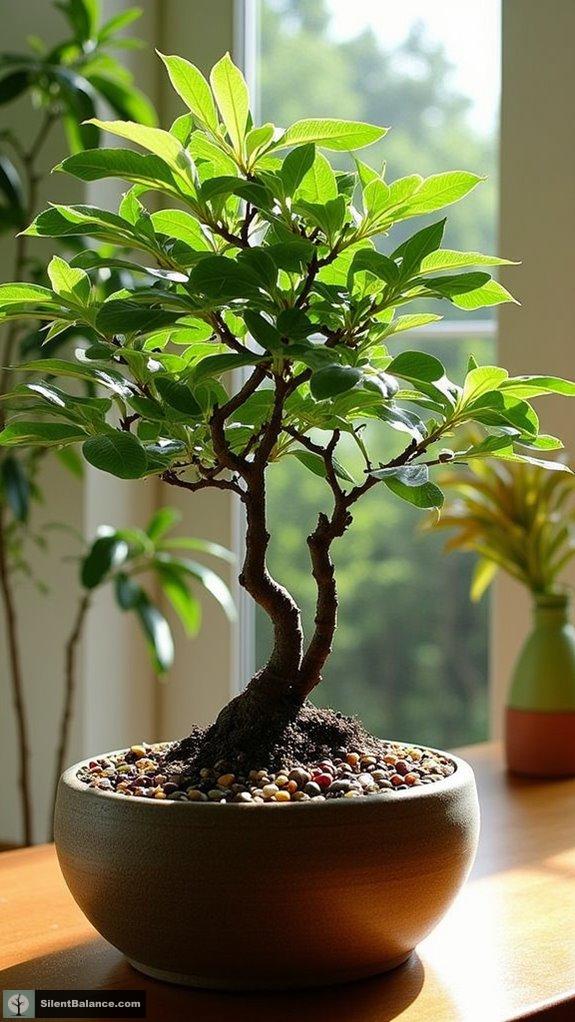
Understanding the unique needs of tropical bonsai can feel a bit like traversing a rainforest—breathtaking, yet slightly overwhelming.
Envision this: your little green friend craves bright, indirect sunlight for about 6 to 8 hours daily, ideally soaking up those rays from a south- or west-facing window. Too much sun? Say goodbye to healthy leaves!
You’ll want to mist those leaves regularly, keeping humidity levels high for that tropical feel. Maintaining 50% humidity is crucial for their thriving, as high humidity levels mimic their native environment.
Don’t forget to keep an eye on soil moisture—never let it fully dry out, or you’ll be in for a sad surprise.
And while you’re at it, recall those cozy temperatures; tropical bonsai aren’t fans of the cold, so keep ’em warm and snug year-round.
Choosing the Right Material for Tropical Bonsai Pots
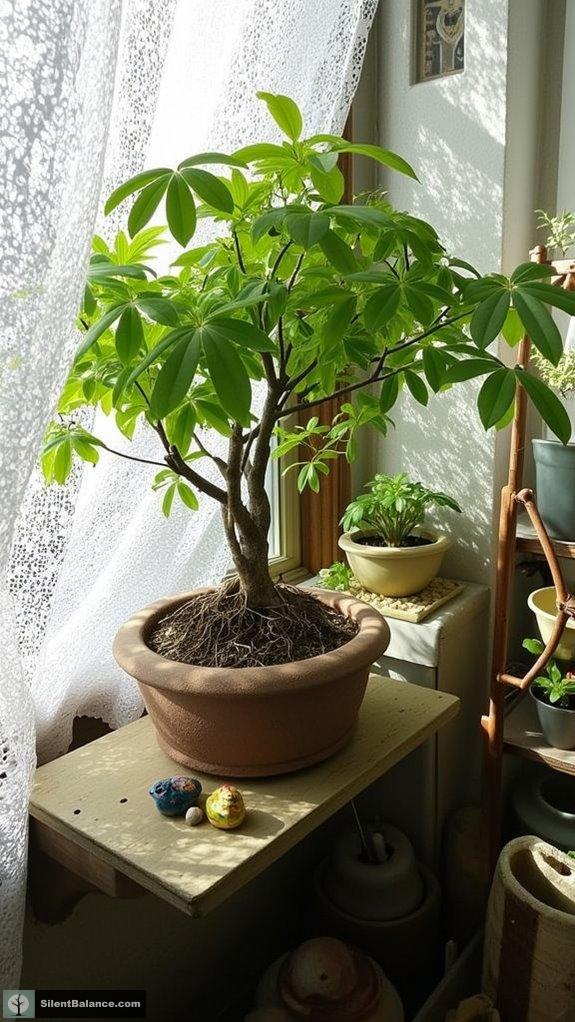
When it comes to choosing the right material for tropical bonsai pots, you’ve got some exciting options on the table, each with its own flair!
Here’s a quick comparison to help you scout the terrain:
| Material | Durability | Aeration |
|---|---|---|
| Ceramic | High | Moderate |
| Clay | Moderate | Good |
| Plastic | Low to Moderate | Low |
| Concrete | Very High | Low |
So, what’s your vibe? If you’re after elegance, ceramic wows with style. For roots craving oxygen, clay’s your bestie! Additionally, choosing the right material can significantly impact your bonsai’s overall health, enhancing its growth and longevity. Using the principles of feng shui can further enrich your bonsai’s environment and balance. If you’re just starting out or want something light, then plastic can work too. Just keep in mind, each material impacts your bonsai’s journey, so choose wisely!
Essential Drainage Features for Healthy Roots

If you want your tropical bonsai to thrive, you can’t overlook the importance of drainage features in your pots.
Think about it: without those precious drainage holes, you’re just asking for trouble. Excess water can quickly lead to root rot, suffocating your beloved tree.
So, I always opt for pots with multiple holes, ideally between 4-8 mm in size, ensuring uniform water flow.
Also, a little tip: elevated feet or pot stands can work wonders by allowing water to escape freely.
And, please, don’t overlook the importance of good soil—something that drains well but still holds on to enough moisture.
Just keep in mind, your bonsai roots need oxygen to flourish, so give them room to breathe!
Balancing Pot Size With Tropical Growth Patterns

Choosing the right pot size for your tropical bonsai can feel like a delicate balancing act, yet it’s essential to get it just right, especially if you want your little green buddy to thrive.
I like to think of it as a dance between tree and pot. For rectangular pots, aim for two-thirds the tree’s height, while round pots should be about one-third.
Keep in mind, the width needs to be narrower than your longest branch; it’s all about that natural expansion vibe!
If your tree’s got a thick trunk, a deeper pot offers stability, while a shallower one suits the delicate sprout.
Don’t stress too much over pot size; regular root pruning lets you keep that green amigo cozy.
Isn’t bonsai fun?
Aesthetic Considerations in Tropical Bonsai Pot Selection
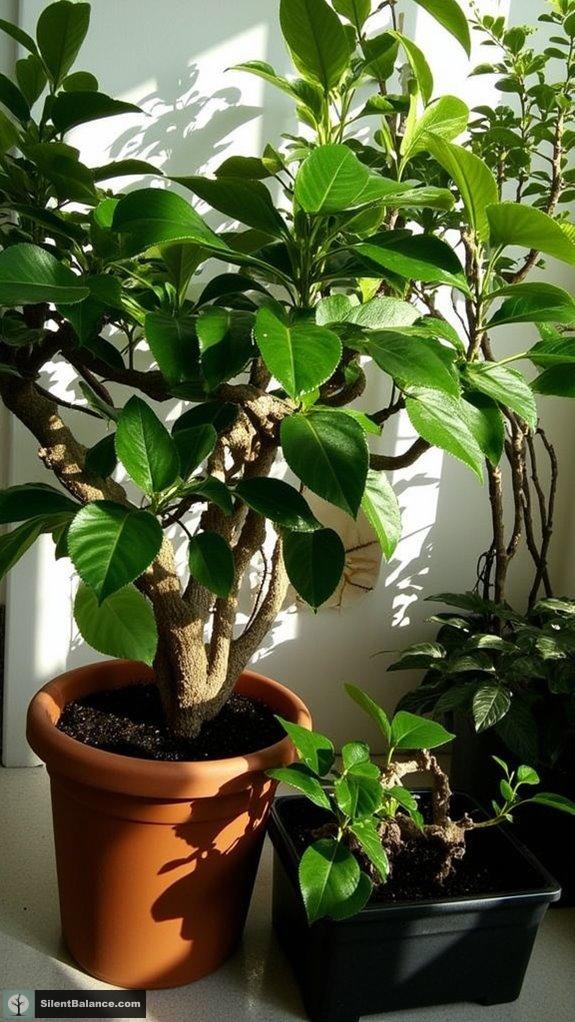
Finding the perfect pot for your tropical bonsai isn’t just about practicality; it’s an art form that accentuates your little green masterpiece.
The color you choose should subtly frame your tree’s charisma without stealing the spotlight. Think earthy tones for a classic look or boldly glazed pots to bounce vibrant energy into the air!
Texture matters too; does your bonsai flaunt coarse bark? It’ll love a gritty finish.
Got smooth bark? Choose a sleek surface for harmony.
And let’s not forget shape—oval pots for rounded canopies or something geometric for those lively tropical forms!
The Impact of Pot Weight on Stability and Growth
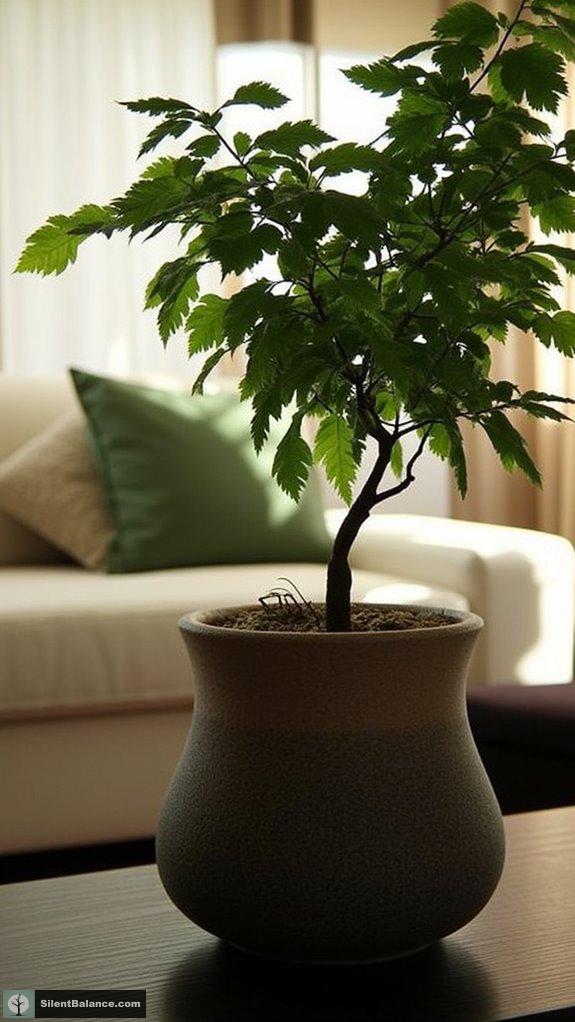
When it comes to the stability and growth of your tropical bonsai, pot weight is one of those little details that can make a big difference.
Heavier pots act like a safety net, preventing our beautiful, top-heavy tree from taking a dive! If your bonsai flaunts an extensive canopy or stands tall, you’ll want to anchor it with something substantial.
Sure, lighter pots sound tempting—until a gust of wind decides to remake your bonsai’s hairstyle.
Some might think, “Heavier means harder to move,” but think of that security! Plus, those dense ceramic or clay pots not only weigh a bit more but also help regulate moisture, nurturing your bonsai’s roots like a warm hug on a chilly day.
Bonsai Tree Symbolism
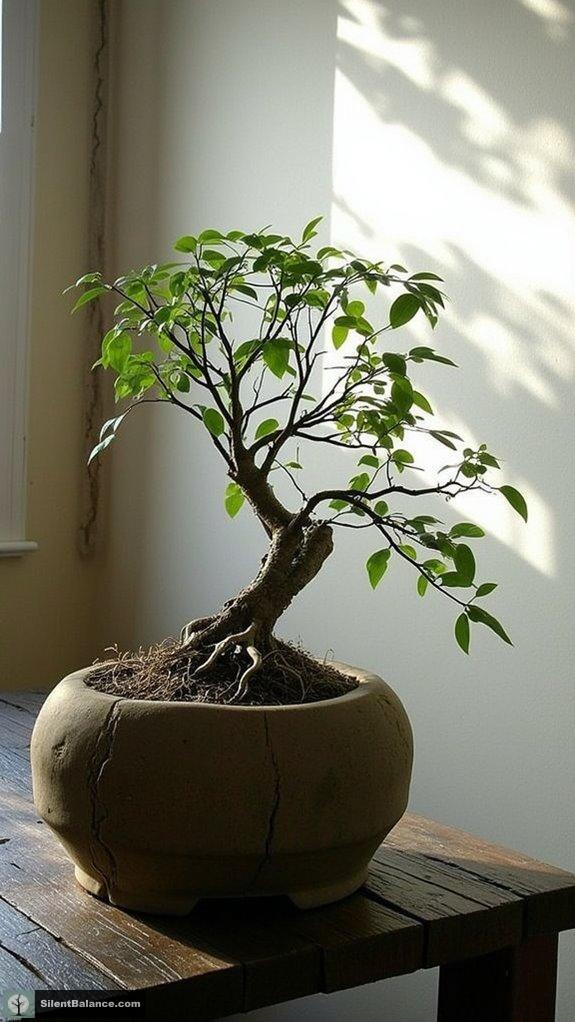
Symbolism in bonsai is like the unseen roots anchoring a tree—deep, complex, and essential for its growth.
These little green wonders represent harmony and balance, don’t they?
It’s amazing how they mirror our own lives, reminding us that peace and natural order blossom from mindful care.
Every twist and turn of their trunks embodies a dance between masculine strength and feminine grace, don’t you think?
Choosing a bonsai isn’t just about aesthetics; it’s about inviting a bit of nature’s wisdom into our space.
Plus, who wouldn’t want a tiny Zen oasis to unwind by, providing a subtle nudge toward mindfulness?
Tree Symbolism
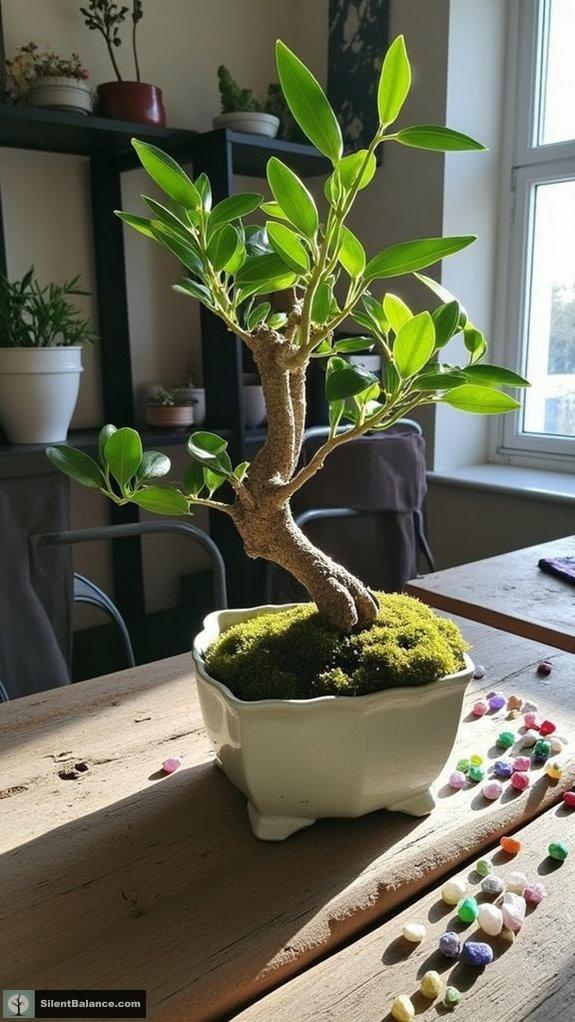
Every tree tells a story, connecting us to ancient wisdom and vibrant cultures.
Take a moment to envision the Tree of Life, a universal symbol linking earth and sky, reminding us of our journey through birth, death, and rebirth. It’s like a cosmic party, where cultures from Greek to Turkish gather to celebrate immortality.
Then there are those enchanting acacia trees in ancient Egypt, whispering tales of resurrection tied to Osiris.
Ever thought about the mighty oak? Rooted in Celtic tradition, it embodies strength and unity—pretty powerful, right?
Even bonsai trees, with their delicate forms, capture these rich narratives. They remind us: nature speaks in whispers of connection, resilience, and, let’s be honest, a little magical flair.
Who wouldn’t want to join that conversation?
Questions and Answers
How Often Should I Repot My Tropical Bonsai Trees?
I’ve learned that I should repot my tropical bonsai trees annually when they’re young and more infrequently—every two to four years—as they mature. Timing’s key; I always check the roots to decide.
Can I Use Regular Garden Soil for Tropical Bonsai Pots?
I wouldn’t recommend using regular garden soil for your tropical bonsai. It can cause drainage issues and harm your tree’s roots. Instead, I suggest a well-balanced bonsai mix for the best results.
What Pests Commonly Affect Tropical Bonsai Trees in Pots?
You wouldn’t believe the number of pests that love tropical bonsai trees! I’ve encountered everything from pesky aphids to sneaky vine weevils. Keeping a close eye and acting quickly has saved my precious plants countless times.
How Do I Know if My Bonsai Pot Is Too Small?
If your bonsai roots are circling, the soil dries too quickly, or growth stalls, it’s likely your pot’s too small. I’ve learned that repotting is essential for keeping my trees healthy and vibrant.
Are There Specific Seasonal Care Tips for Tropical Bonsai?
Did you know tropical bonsai can take temperatures as low as 35°F? During winter, I always bring mine indoors, ensuring they get enough light and moisture for happy, healthy growth. Don’t forget to avoid pruning or fertilizing!
References
- https://www.pubs.ext.vt.edu/426/426-601/426-601.html
- https://www.bonsaiempire.com/basics/bonsai-care/choosing-pots
- https://www.bonsaiable.com/blog/pots-for-bonsai-trees
- https://www.bonsaioutlet.com/what-size-pot-to-use-for-your-bonsai-tree/
- https://www.youtube.com/watch?v=xWHwez_n2G0
- https://bonsaiandbrewstudio.com/blogs/news/tropical-bonsai-tree-care
- https://www.marylandbonsai.com/bonsai-tips
- https://bonsaiwest.com/resources/bonsai-care/
- https://www.youtube.com/watch?v=Gd10lsl8tQU
- https://plantcitybonsai.com/bonsai-care
- https://japanesegardencraft.com/material-selection-for-bonsai-pot/
- https://bonsaitonight.com/2021/03/07/what-kind-of-soil-should-i-use-for-my-bonsai/
- https://www.bonsainut.com/threads/best-substrate-for-tropical-bonsai.64926/
- https://www.sungreenbonsai.com/post/choosing-the-perfect-container-for-your-bonsai-bonsai-container-tips-and-best-practices
- https://www.bonsaiempire.com/blog/bonsai-soil-requirements
- https://www.allthingsbonsai.co.uk/bonsai-tree-care/indoor-bonsai-care/
- https://www.youtube.com/watch?v=yMKjZKAoqH8
- https://www.bonsaiempire.com/forum/repotting-and-soil/7397-can-i-use-pots-with-no-drainage-holes
- https://premierbonsai.co.uk/contents/en-uk/d2111895.html
- https://www.bonsaify.com/blogs/news-and-more/growing-bonsai-trees-how-big-do-they-get
- Perfect Pots for Thriving Tropical Bonsai Tree Containers - September 5, 2025
- Top 10 Bonsai Tree Designs for Miniature Home Greenery - September 5, 2025
- What Are the Easiest Bonsai Tree Species for Minimal Care? - September 5, 2025

